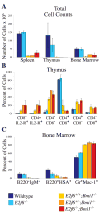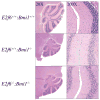E2f6 and Bmi1 cooperate in axial skeletal development
- PMID: 18366140
- PMCID: PMC2697036
- DOI: 10.1002/dvdy.21516
E2f6 and Bmi1 cooperate in axial skeletal development
Abstract
Bmi1 is a Polycomb Group protein that functions as a component of Polycomb Repressive Complex 1 (PRC1) to control axial skeleton development through Hox gene repression. Bmi1 also represses transcription of the Ink4a-Arf locus and is consequently required to maintain the proliferative and self-renewal properties of hematopoietic and neural stem cells. Previously, one E2F family member, E2F6, has been shown to interact with Bmi1 and other known PRC1 components. However, the biological relevance of this interaction is unknown. In this study, we use mouse models to investigate the interplay between E2F6 and Bmi1. This analysis shows that E2f6 and Bmi1 cooperate in the regulation of Hox genes, and consequently axial skeleton development, but not in the repression of the Ink4a-Arf locus. These findings underscore the significance of the E2F6-Bmi1 interaction in vivo and suggest that the Hox and Ink4a-Arf loci are regulated by somewhat different mechanisms.
Figures






Similar articles
-
Bmi1 promotes hepatic stem cell expansion and tumorigenicity in both Ink4a/Arf-dependent and -independent manners in mice.Hepatology. 2010 Sep;52(3):1111-23. doi: 10.1002/hep.23793. Hepatology. 2010. PMID: 20648475
-
A novel zinc finger protein Zfp277 mediates transcriptional repression of the Ink4a/arf locus through polycomb repressive complex 1.PLoS One. 2010 Aug 24;5(8):e12373. doi: 10.1371/journal.pone.0012373. PLoS One. 2010. PMID: 20808772 Free PMC article.
-
Transcriptional coactivator Cited2 induces Bmi1 and Mel18 and controls fibroblast proliferation via Ink4a/ARF.Mol Cell Biol. 2003 Nov;23(21):7658-66. doi: 10.1128/MCB.23.21.7658-7666.2003. Mol Cell Biol. 2003. PMID: 14560011 Free PMC article.
-
BMI1 as a novel target for drug discovery in cancer.J Cell Biochem. 2011 Oct;112(10):2729-41. doi: 10.1002/jcb.23234. J Cell Biochem. 2011. PMID: 21678481 Review.
-
Bmi1, stem cells, and senescence regulation.J Clin Invest. 2004 Jan;113(2):175-9. doi: 10.1172/JCI20800. J Clin Invest. 2004. PMID: 14722607 Free PMC article. Review.
Cited by
-
Dnmt3b recruitment through E2F6 transcriptional repressor mediates germ-line gene silencing in murine somatic tissues.Proc Natl Acad Sci U S A. 2010 May 18;107(20):9281-6. doi: 10.1073/pnas.1000473107. Epub 2010 May 3. Proc Natl Acad Sci U S A. 2010. PMID: 20439742 Free PMC article.
-
Evolutionary changes of Hox genes and relevant regulatory factors provide novel insights into mammalian morphological modifications.Integr Zool. 2018 Jan;13(1):21-35. doi: 10.1111/1749-4877.12271. Integr Zool. 2018. PMID: 28685945 Free PMC article.
-
E2F6 initiates stable epigenetic silencing of germline genes during embryonic development.Nat Commun. 2021 Jun 11;12(1):3582. doi: 10.1038/s41467-021-23596-w. Nat Commun. 2021. PMID: 34117224 Free PMC article.
-
Angular limb deformity associated with TSPAN18, NRG3 and NOVA2 in Rambouillet rams.Sci Rep. 2023 Sep 25;13(1):16059. doi: 10.1038/s41598-023-43320-6. Sci Rep. 2023. PMID: 37749158 Free PMC article.
-
E2f3a and E2f3b make overlapping but different contributions to total E2f3 activity.Oncogene. 2008 Nov 20;27(51):6561-70. doi: 10.1038/onc.2008.253. Epub 2008 Jul 28. Oncogene. 2008. PMID: 18663357 Free PMC article.
References
-
- Adler PN, Martin EC, Charlton J, Jones K. Phenotypic consequences and genetic interactions of a null mutation in the Drosophila Posterior Sex Combs gene. Dev Genet. 1991;12:349–361. - PubMed
-
- Akasaka T, Kanno M, Balling R, Mieza MA, Taniguchi M, Koseki H. A role for mel-18, a Polycomb group-related vertebrate gene, during theanteroposterior specification of the axial skeleton. Development. 1996;122:1513–1522. - PubMed
-
- Akasaka T, Tsuji K, Kawahira H, Kanno M, Harigaya K, Hu L, Ebihara Y, Nakahata T, Tetsu O, Taniguchi M, Koseki H. The role of mel-18, a mammalian Polycomb group gene, during IL-7-dependent proliferation of lymphocyte precursors. Immunity. 1997;7:135–146. - PubMed
-
- Akasaka T, van Lohuizen M, van der Lugt N, Mizutani-Koseki Y, Kanno M, Taniguchi M, Vidal M, Alkema M, Berns A, Koseki H. Mice doubly deficient for the Polycomb Group genes Mel18 and Bmi1 reveal synergy and requirement for maintenance but not initiation of Hox gene expression. Development. 2001;128:1587–1597. - PubMed
-
- Alkema MJ, Bronk M, Verhoeven E, Otte A, van ’t Veer LJ, Berns A, van Lohuizen M. Identification of Bmi1-interacting proteins as constituents of a multimeric mammalian polycomb complex. Genes Dev. 1997;11:226–240. - PubMed
Publication types
MeSH terms
Substances
Grants and funding
LinkOut - more resources
Full Text Sources
Other Literature Sources
Molecular Biology Databases

